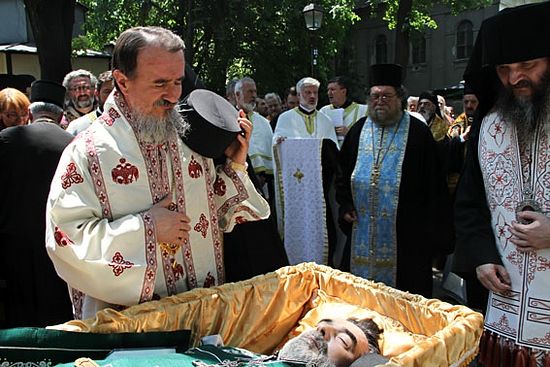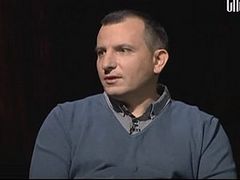In the name of the Father, and the Son, and the Holy Spirit. Amen.
Though I’ve not been a priest for very long, I have noticed that there’s been a lot of confusion concerning death and the customs of the Orthodox Church regarding the funeral rites. Because of this, I want to take this time to educate you on the customs of the Church and their meanings.
The moment of death and afterwards
I will begin by briefly discussing the funeral rites. It is expected that all Orthodox Christians have lived a life of daily personal prayer, of studying the scriptures, of faithfully attending all the services, of partaking of the sacraments, of fasting, and of giving alms.
When an Orthodox Christian is close to death the parish priest may be called. There are prayers that can be offered before death asking the Lord for the departure of the soul. If the person has been suffering for a long time, this can be comforting.
Once the person has departed, there are prayers that can be offered by the parish priest before the body is moved to the funeral home.
Then, according to the custom of the Greek Archdiocese of America, when the funeral date is set, the priest will come to the funeral home the night before the funeral and offer the Trisagion prayers. A visitation may precede this service.
On the day of the funeral, the priest will meet the casket in the parking lot and sing “Holy God” as the casket is brought into the church. Immediately the funeral will begin. Once the funeral has ended, and the deceased’s family and friends have offered the last kiss, the priest will lead the casket to the hearse singing “Holy God.”
Once they have reached the burial site, the priest will once again offer the Trisagion prayers.
Regarding cremation
The Orthodox Church does not permit cremation for several reasons. This is one of those hard and fast rules, and there are very few exceptions.
“The Orthodox Church teaches that the body is the temple of the Holy Spirit (see I Cor. 3:16; 6:19). The truth that our Lord and Savior Jesus Christ was buried and bodily resurrected is the reason we follow burial of the physical body, rather than cremation. Death is the beginning of the new and abundant life in Christ. A church funeral is denied to an Orthodox Christian who has been or will be cremated. In addition, since cremation contradicts the practice of the Church, there should be no Trisagion or individual Memorial Service offered for a person who has been cremated. (The name of the individual may be given during the Saturday of the Souls memorial. Exceptions may be made by the local Hierarch.)”1
Deacon Mark Barna, in his podcast on Ancient Faith Radio2 addressed some particular reasons why Orthodox Christians are not to be cremated. Let me briefly summarize his discussion.
He points out that cremation does violence to the body, which is regarded as an image of Christ. Thus the body is the temple for the Holy Spirit, where the living God dwells. Though some religions - such as Buddhism and Hinduism – teach that the body is a corrupt prison for the soul, Orthodox Christians don’t believe this. Instead, we believe that the whole person is made up of soul and body. We believe that when Christ returns, the body will be resurrected and reunited with the soul, just as it was meant to be.
Dn. Mark has several points: 1) that the body is a gift from God, 2) that God breathed life into the body, 3) humanity was meant to know God through its experience in the body, and 4) that when Christ put on a body in the incarnation, even with all its weaknesses, the body was glorified. Thus the idea of total depravity of the flesh is unknown in Orthodox theology.
Dn. Mark continues in his podcast to point out the importance of relics to the Orthodox Church. Relics are found in every altar, and in every antimins. We venerate the relics of saints, which remind us of their holiness. Obviously, cremation would make relics hard to come by. Commenting on relics Dn. Mark continues,
“What are relics anyway? The pieces of a Christian body, sanctified through a life of prayer, labor, and sacrifice in the Church. We bless an icon one time and revere it for all time. A Christian body is baptized, blessed, and anointed over and over again. It’s nourished by the very body and blood of our Lord God and Savior Jesus Christ throughout our entire life. Hopefully our last act will be to receive the holy Eucharist before our death. It is, in fact, an icon of Christ Not-Made-by-Hands. Surely the relics of the most common of Orthodox Christians are worthy of ultimate respect...
“Respect is a vital issue we’ll be returning to throughout these podcasts, and that brings up the final—and I think the most important—point about cremation. As Christians, particularly Orthodox Christians, our whole life is to be lived in reverence, love, and humility before God and one another as his image. Our obedience and humility is the ultimate show of respect for God and for his creation. After all, it’s disobedience that got us into this mess to start with. If we read the holy Scriptures, the lives of the saints, and the writings of the holy Fathers, we find constant reminders of humility before God. ...
“This [cremation], then, rather than humble submission to the will of God, becomes as our final act an act of pride. After a life of work to acquire the Holy Spirit, the Spirit of humility and the Spirit of love, should we throw it away at the last moment with a prideful decision? I don’t think so, and I hope you agree. The prohibition against cremation in the Orthodox Church is not just the Church trying to dictate how we live and die, and it’s not just some antiquated tradition. It is the Church trying, once again, to guide us into a God-pleasing way of life, and in this case, a God- pleasing way of death and burial.3
Inhumation/embalming/cemetery
The proper way to bury a person is inhumation, that is, a bodily burial. However, in America, it has become the custom to embalm the body, which is a tradition that started during the Civil War. The reasons given are thus: to disinfect, to preserve, and to restore a life-like appearance for viewing. However, none of these arguments hold up. I refer to the book A Christian Ending for more information. Embalming involves opening the body and draining the blood, which does harm it, and treats the body as less than a sacred temple. The body becomes an it – a thing to be suctioned, plugged, stapled, painted, and put on display.
Because of this, and because the blood is seen as a part of the body and sacred, it is preferred that one does not embalm. Rather a natural burial, sometimes known as a green burial in contemporary America, is to be preferred. It should be noted, though, that although embalming is frowned upon, the Church will still conduct a funeral for one who does undergo this procedure.
It is also preferred that one is buried in a simple burial shroud without fancy clothes or jewelry. As is stated in the book mentioned earlier, “Each individual, king or pauper, stands before the Righteous Judge, naked and alone. The essence then of the Christian funeral is simplicity and humility. There is no great show of earthly wealth, fame or accomplishment, for all those things are dust, just as the body shall soon be.”4
It is also recommended that the coffin or casket also be simple. A cardboard box will do just fine, or, if one must, a simple wooden box will also do. It is also recommended that one not use a vault in the burial plot. The vault is a concrete box in the ground in which the coffin is placed. This prevents contact with the earth. “Placed in contact with the earth, the body returns naturally to its maker and is placed in His holy hands to do with as He wills.”5 A liner, which only covers the sides and top of the coffin, may be acceptable, because the bottom still allows the coffin to rest on the natural ground.
As you can see, it is preferred that one keep the funeral arrangements as simple and natural as possible. If you are a wealthy person, the money saved on the funeral should be given away as alms. We should die as Christians, and so we shouldn’t have fancy funerals lest we sin even in death! As Ecclesiastes says, “Vanity of vanities, says the Preacher; all is vanity” (12:8).
The memorial/panikhida6
Memorials (or if there’s no Kolliva, then the Trisagion, which is an abbreviated version of the Memorial), also called Panikhidas, are typically celebrated on the 3rd, 9th, and 40th days after death.Tradition states that angel once told St. Macarius the reasons why we celebrate the Memorial on particular days. Though the story related by the angel may be best understood as a parable, it does teach us the seriousness with which the Orthodox Christian should take their walk with Christ.
It goes that the angel replied to St. Macarius that we celebrate on the 3rd day for several reasons. 1) This is the day when one’s guardian angel provides relief for the soul, which is grieving the loss of its body. Tradition states that the soul is permitted to wander the earth for the two days immediately following death. 2) It is also on the 3rd day that Christ rose from the dead, and so this is the day that the soul goes to heaven to reverence God.
For the next 6 days (between the 3rd day Trisagion and the 9th day Trisagion) the angels now show the departed soul all the abodes of the saints and the beauty of paradise. If the person lived a faithful Christian life, then the soul rejoices in seeing these things. If, however, the person lived a life of sin, the soul will wail and reproach itself. Then, on the 9th day, the soul again goes to heaven to reverence God. Thus, on the 9th day, after the soul has viewed paradise, we celebrate a Trisagion on the 9th day.again goes to heaven to reverence God. Thus, on the, after the soul has viewed paradise, we celebrate a Trisagion on the 9th day.
For the next 30 days the soul now tours Hades and witnesses the torments of the ungodly. The soul will tremble lest it be condemned to imprisonment therein. Then on the fortieth day the soul is again taken to heaven to reverence God. It is on this fortieth that the soul is judged by Christ and either condemned below or joins the glory of the saints. This is why we celebrate the Trisagion on the fortieth day.
It is also customary to celebrate the Trisagion on the anniversaries of birthdays, name-days, and death-dates.
Kolliva (boiled wheat)
“It is customary among Orthodox Christians...to bring a tray of boiled wheat kernels [called Kolliva] to church for the memorial service. The wheat kernels express belief in everlasting life. Jesus said, ‘Unless a grain of wheat falls into the earth an dies, it remains alone, but if it dies, it bears much fruit’ (John 12:24). Just as new life rises from the buried kernel of wheat, so we believe that the one buried will rise one day to a new life with God. The wheat kernels are covered with sugar and raisins to express the bliss of eternal life with God in heaven.7
Conclusion
The value of the body is immeasurable, and a Christian death is beautiful. “God the Logos lived in a human body animated by the breath of God. He sanctified it and returned it to His Father restored and unblemished. Jesus loved, respected and cared for the body of persons who were sick, hungry or grieved. Much of His earthly ministry involved healing bodies as well as souls.8 So as Orthodox Christians, we treat the departed loved one with respect in burial and through prayer services.
If you would like to learn more, or purchase a burial shroud or coffin, please visit this website: www.achristianending.com





